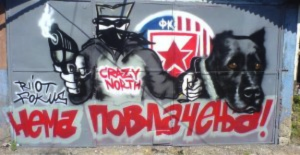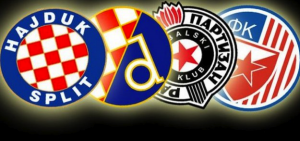The historically vicious Belgrade derby took place earlier this month on November 2nd. While Red Star clearly dominated the match, the only goal posted during the game was by Partizan defender Milan Obradovic, who accidentally scored on his own keeper with a header in the 18th minute. Partizan fans took home a loss from Red Star, but not before setting fire to the stands of Red Star’s Marakana stadium [1].
Article/Video: http://www.euronews.com/2013/11/04/belgrade-derby-stopped-by-partizan-fans-setting-fire-to-stand/
Three days later, David Goldblatt, author of The Ball is Round: A Global History of Soccer, graced our class with his presence. Goldblatt has traveled the world to research football for his book, and when asked to describe the most memorable and amazing football spectacle he had ever experienced, he immediately stated, “Serbia.” Coincidentally, Goldblatt went on to recount one of the Belgrade derbies he had the fortune of attending, detailing lots of violence, “pyrotechnic” hooligan fans, and ferocious Serbian military police.
As Goldblatt touched upon in class, the Partizan-Red Star rivalry is much more than just sport and friendly competition. Serbia’s Slavic neighbor, Croatia also shares in the fierce rivalry with Serbia, and similarly between its own club teams: Dinamo-Zagreb and Hajduk-Split. Serbian and Croatian football have an intertwined and violent history, which symbolized and even played a role in the tension and fighting before the Yugoslav Wars of the 1990s.
Serbia: Red Star vs. Partizan
For most Serbians, their die-hard allegiances are split between two Belgrade teams, Red Star and Partizan.
Although the quality on show during the ‘Veciti Derbi’ (Eternal Derby) has slipped since the break-up of the former Yugoslavia and the regular exodus of the brightest talents, the rivalry itself has perhaps even intensified to compensate for fan frustrations on a sporting level.
-FIFA Classic Football Rivalries [2]
Red Star’s “Delije” (Heroes) and Partizan’s “Grobari” (Undertakers) were both established in 1945 only a few months apart. Both teams came into existence after WWII by different political entities: Red Star by the Yugoslavian Communist Party and Partizan by the Yugoslav People’s Army. Red Star holds 25 league titles, 24 national cup titles, and 4 international cup titles, while Partizan holds 25 league titles, 12 national cup titles, and 1 international cup title. A power struggle existed between the Ministry of the Interior (Serbian Secret Police) and the Ministry of the Defense in Serbia, fueling this competitive rivalry [2].
Croatia: Dinamo vs. Hajduk
Hajduk-Split, one of Croatia’s premier clubs located on the Adriatic coast, was established in 1911 by four students. Their professor gave them the name “Hajduk” (Insurgents), saying “that which is best in our people: bravery, humanity, friendship, love of freedom, defiance to powers, and protection of the weak. Be worthy of that great name.” [3] Since then, the team has been nicknamed “Champions from the coast,” earning 18 league titles and 21 cup titles.
Dinamo-Zagreb from the north, Hajduk’s rival, was founded following World War II in 1945 when two Zagreb clubs, HASK and Gradanski, merged. Since its establishment, Dinamo has racked up 19 league titles, 24 domestic cup titles, and two international cup titles [4].
Croats with Dalmatian license plates (Zadar, Split, etc) keep an eye on their cars in the north, particularly in Zagreb. My Dalmatian friend keeps Dinamo Zagreb fans, aka the “Bad Blue Boys,” off his car by displaying their team’s merchandise on his dash, most notably a pennant depicting a bulldog (the symbol of the Bad Blue Boys) ripping apart a Dalmatian dog.
-Ivan, Croatian Football Fan
Era of the “Big Four”
There exists a clear distinction for both Serbia and Croatia in football before and after 1991. Prior to 1991, there persisted four major clubs in Yugoslavia called the “Big Four”: Dinamo-Zagreb, Hajduk-Split, Partizan-Belgrade, and Red Star-Belgrade (as you probably guessed) [6].
Ethnic tensions between the Serbs and Croats escalated after the death of Yugoslavian President, Josip Broz Tito in 1980. Tito successfully appeased both nations, keeping Yugoslavia relatively peaceful, and avoiding the pre-1974 Serbian hegemony. Unfortunately, Serbian dominance in Yugoslavian politics returned with the help of Serbian politician Slobodan Milošević [7].
Derbies within republics (Dinamo vs. Hajduk, Red Star vs. Partizan), reflected a time of less violence. In Croatia, the Eternal Derby between Dinamo and Hajduk was especially important, as it represented the opportunity to show Croatian pride over Yugoslavian pride. Both Dinamo and Hajduk fans felt that Serbian teams were their suppressors and true rivals. Croatian fans left derbies with a sense of national pride and brotherhood, regardless of the match outcome [6].
The growing tensions between Croatia and Serbia reached a climax on May 13, 1990 at Maksimir stadium in Zagreb during a match between Dinamo and Red Star. Two weeks prior to the match, the Croatian Democratic Union had their first free parliamentary elections, directly opposing Serbia and Milošević’s communist Yugoslavia [6].
Red Star fans were brought to Zagreb for the match under fan leader, Željko “Arkan” Ražnatović. Hours before the game, fights had already broken out in the streets of Zagreb between Dinamo (Bad Blue Boys) and Red Star (Delije) fans. The violence carried over into the start of the game, where Delije began to destroy the stadium. When the Bad Blue Boys attempted to fight back, Serbian regime police at the match selectively chased and charged Croatian supporters.
Dinamo captain, Zvonimir Boban, after watching a police officer beat a Dinamo fan with his bat, jumped onto the officer, delivering a historical “kun-fu-style” kick, knocking him down and allowing the fan to escape.
That day summed up all the bad side of Yugoslav politics that was present for 50 years, the unfairness to Croatian people, the injustice. … When our fans wanted to protect our stadium, our home, our Zagreb, Dinamo, and Croatia, the police acted in an incredibly drastic and aggressive way. They started to beat up the fans to crush them.
-Zvonimir Boban, former Dinamo Midfielder [6]
Boban’s kick became legendary, and the Dinamo Zagreb-Red Star Belgrade riot of 1990 became symbolic of the Croatian nationalism and discontent with Yugoslavian politics. Many believe the riot sparked the Croatian War of Independence that began a year and a half later, claiming “the war started in Maksimir.”
Serbia’s role as the pride of Yugoslavia was solidified in 1991 when Red Star won the European Champion Clubs’ Cup, the greatest success in Yugoslav football history. While the accomplishment represented the country as a whole, it was celebrated as a Serbian triumph, and further “[stoked] the flames for ethnic nationalism” [8].
As tensions and conflict loomed, football fans became soldiers. Many Croatian football fan groups joined the Croatian army. Arkan’s fan group, the Delije, eventually became a paramilitary group called the “Serb Volunteer Guard” and eventually “the Tigers.” The Tigers would go on to commit various war crimes, including murder and rape.
Post-Conflict
To this day, Serbian and Croatian fans are known to take their responsibilities as football supporters very seriously. In a match against Italy in 2010, Serbian fans threw flares on the pitch. The game was abandoned after seven minutes, resulting in a 3-0 loss to the Italians [9]. In 2012, Croatian fans exhibited severe racism against Italian player, Mario Balotelli with racist chants [10] and banana (and flare) throwing on the pitch [11]. The Croatian football association sustained a hefty $100,000 fine from the UEFA.
The World Cup Qualifying matches this year turned out to be the first time Croatian and Serbian national teams played head-to-head since 1999. The first qualifying match in March of 2013 took place in the historical Maksimir stadium, with high anticipation for violence. Authorities from both countries agreed to keep visiting fans away, and no major issues arose. Croatian fans, however, were “unable to resist the urge to chant things like ‘Ubij, ubij Srbina’ (‘kill a Serb’) during the encounter” [12].
The first match in March resulted in a 2-0 win for Croatia, and a draw in Belgrade in September. Croatia is still in the running for World Cup Qualification, playing Iceland tomorrow, November 19th!
References:
[1] http://asia.eurosport.com/football/european-football/2013/red-star-beat-partizan-in-troubled-belgrade-derby_sto3990724/story.shtml
[2] http://www.fifa.com/classicfootball/clubs/rivalries/newsid=1206159/index.html
[3] http://www.gfdb.com/Club.1646.Hajduk-Split.aspx
[4] http://www.fifa.com/classicfootball/clubs/rivalries/newsid=112078/index.html
[6] http://www.youtube.com/watch?v=j8azzIOmhzU&list=PLpSTSVIjB0PUHUN8SKUy74G-daxKsIBix
[7] http://vlib.iue.it/history/europe/yugoslavia.html
[8] http://www.opendemocracy.net/can-europe-make-it/ivan-djordjevic/red-star-serbia-never-yugoslavia-football-politics-and-national-i
[9] http://www.theguardian.com/football/2010/oct/12/italy-serbia-called-off-crowd-trouble
[10] http://www.nydailynews.com/sports/euro-2012/euro-2012-uefa-fines-croatia-football-association-100-000-fans-racially-abused-italy-mario-balotelli-article-1.1098413
[11] http://www.dailymail.co.uk/sport/euro2012/article-2159847/Euro-2012-UEFA-investigate-banana-thrown-pitch-Italy-v-Croatia.html
[12] http://www.dw.de/croatia-beats-serbia-2-0-in-no-ordinary-game/a-16694684






